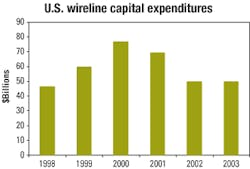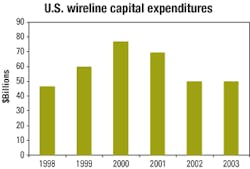2002 is the year of the design win
Economic hurdles will continue to hamper growth for the next 18 months.
BY TOM HAUSKEN
With the U.S. economy looking better, many are asking if the telecommunications industry is on the verge of a recovery. At Strategies Unlimited, we expect that the overall market cannot recover until the carriers resolve their complicated financial troubles, and that takes time to work out-the next 18 months, at least. Does that suggest that 2002 is not an important year for suppliers? Definitely not, but first let's review the situation.
Debt problems don't go away easily
Bill Clinton's election team managed a successful campaign in 1992 by repeating the now-famous mantra, "It's the economy, stupid." The crisis in the telecom industry, though, is not about the economy. It is not even about the so-called glut of fiber or bandwidth. A glut of competitors? Maybe.
The current crisis is really about debt and a mess of relationships among the carriers. When one carrier cannot continue to meet its interest obligations, it seeks refinancing or its assets are liquidated. That sets off a chain reaction of falling dominos. New restructured companies will have reduced debt obligations-and new owners-and can compete more effectively against still-solvent companies. Carriers that leased capacity to newly bankrupt companies and expected revenues from them, will be pushed closer to the brink. Everyone will feel the pain.
Events will continue to unfold, with resolution coming step by step. Carriers will continue to cut back on capital expenditures and eventually reduce their obligations. Failing companies will be consolidated or liquidated, reducing competition. Prices will stabilize, and profits will return. How long will that take? Expect some stabilization next year, but a return to growth in capital expeditures must wait until 2004.The Figure shows our expectations for capital expenditures for wireline operations of U.S. carriers through 2003. Some help is expected from Asia, however, with China representing a small but very high-growth investment in infrastructure.
Compare that to the prospects for system vendors such as Alcatel, Lucent Technologies, and Nortel Networks. Revenues for these vendors followed a wider swing, dipping 31% from 2000 to 2001. These companies provide infrastructure for the carriers, but the current climate is no time to be investing in new infrastructure, unless absolutely necessary.
Moving down the supply chain, the outlook for suppliers of components sees yet a wider swing in the cycle. When the financial brakes were applied and orders were cancelled, the component suppliers were the last to be notified. Their orders were cancelled just as they were still ramping production. Inventory accumulated rapidly, with little residual demand to relieve it. Consequently, sales for component vendors fell 55% from 2000 to 2001, and we expect them to fall another 60% in 2002.
Interestingly, this steep fall from 2001 to 2002 is happening despite the fact that we expect some recovery in quarter-to-quarter growth in 2002 as inventories are reduced. While it seemed at the time that first and second quarter 2001 results were a disaster, they were nevertheless the brightest quarters of last year. In 2002, in contrast, the market can almost only go up, but not enough to match the 2001 sales.
Strategies needed to survive
Capital flows into the industry have been curtailed severely. The typically long delay from offering a new product to shipping in volume is now extended further. There are too many suppliers. Many companies will fail. Both young and established players will need to add the following strategies to survive the downturn:
- Temper ambitions. Most product segments will not support more than four to six suppliers. Unless a company has a plan that will make it one of those major suppliers-which means competing with the likes of Corning, Agere, Alcatel, Nortel, and JDS Uniphase-that company should aim for a "niche" strategy and temper its expectations of financial return accordingly. All players should be prepared to develop acquisitions or be acquired. They also should be ready to "pull the plug" if they are unable to pull together a complete formula for success.
- Integrate: Tie electronics and optics together. The true test of a company's competitive position will be that it has a strong handle on both electronics and optics. Systems equipment companies will be buying line cards and shelves, not discrete components, so component makers must take a systems approach to design.
- Keep a rein on fixed costs. Not every industry participant needs to own its own fab or assembly plant. Contract manufacturers and foundries will be vital to younger companies that need to conserve resources.
- Keep an eye on inventories throughout the supply chain. During periods of product shortages, a number of companies became lax about managing their inventory levels or getting a handle on their customers' inventory position. Failure to have an "early warning system" on inventories led to massive write-downs and wastage. Here, too, contract manufacturers, which assume responsibility for managing inventories on behalf of their clients, can be of assistance.
- Keep investing in R&D. When the industry emerges from its current recession, it will be ready to purchase the next generation of products. Product development efforts must continue so that industry players can "power out" of the slump.
This year-the year of the design win-is critical. The component suppliers that emerge from the downturn will be familiar names but not necessarily names with a long history in this industry. They will win orders on performance and price, but also promise staying power. Startups have their place, too. They bring many of the best ideas and will always be attractive as acquisition targets for the bigger companies that have essentially outsourced their R&D to the general market.
Tom Hausken is director of optical communications components at market research and analysis firm Strategies Unlimited (Mountain View, CA).


